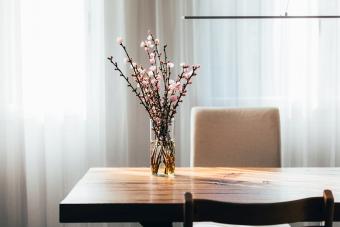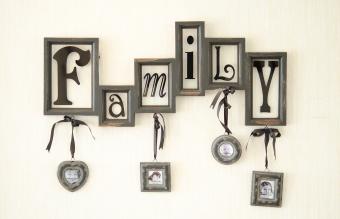
With the long list of vase shapes and styles, you'll find the one that best suits your home's vibe with this style breakdown. From understated and traditional to contemporary and downright artistic, these designer vase tips will help you fill and style the vessels that speak to you. Once you know all the vase shapes and how to style each vase, you can select your flowers and your vessel like a pro for an instantly stunning decor detail.

Bouquet Vase

For a versatile vase that showcases your floral arrangements and elevates your style, the traditional bouquet vase is an easy choice. This vase is the ideal choice to display a bouquet in a transitional style, as it's larger on the bottom with a wide and open top to bear the weight of heavy blooms. Full arrangements work well in this vase, though a collection of your favorite sprigs and picks fit just as well. Also versatile in interior style, the bouquet vase looks elegant in traditional styles, and its curves and feminine essence shine in styles like granny chic and cottagecore.
Cylinder Vase

Also perfectly fitting for a bouquet, the cylinder vase trades the traditional curves of the bouquet vase for cleaner vertical lines. You might recognize this vase style as the typical flower arrangement vessel used by florists and retailers for floral gifts. From tall and slender, to short and stout, the cylinder vase complements traditional and contemporary styles. Fill it with traditional arrangements with full blooms and slim stems or look for florals or sprigs that are sturdier and linear.
Fluted Vase

Elegance has entered the vase chat. The fluted vase brings an understated elegance to your home in a timeless way. This vase can be similar in shape to the bouquet or the cylinder vase - the main difference being those subtle and sophisticated ribs. This little texture detail gives traditional and contemporary shaped vases a stylish update. Use understated florals for these vases or opt out of an arrangement to let the texture details of the fluted vase shine.
Pedestal Vase

If you're looking for a vase that makes a statement in a classy way, the pedestal vase comes in a wide range of styles, materials, and sizes. Also called a pedestal bowl, this vase shape is best suited to faux floral arrangements with short bases. You might also swap a traditional floral arrangement for alternative filler like fruit (fresh or wax), decorative orbs, or strands of decorative beads.
Bud Vase

Small in stature but big in style, the bud vase is a miniature version of the traditional vessel. As the name suggests, a bud vase is meant for one or two single blooms rather than a robust arrangement of flowers. These little vases look just as beautiful empty as they do with a dainty sprig. Use them in a collection on the windowsill or fireplace mantel. Use singular bud vases to complement larger decor items on your nightstands or coffee table.
Bowl Vase

Though technically a bowl, this floral arrangement vessel is most often used as a vase. Perfect for arrangements with short and tightly bound stems, the ceramic or glass bowl can stylishly display a bouquet with heavy and voluminous blooms. Peonies and hydrangeas help a bowl vase look full and balanced. Save your tulips and lilies for taller, more slender vases.
Trumpet Vase

A true statement for a centerpiece, the trumpet vase is for the most ostentatious events, rooms, and flowers. Often seen at large events like weddings or in formal dining rooms, this vase is often larger than the average floral container and is most often made of glass or crystal. A trumpet vase has a long, thin neck and flared top, proving its name accurate. This allows for only a small gathering of florals with small stems, though the large opening means you can choose stems with a large and rounded collection of blooms.
Square Vase

Another short stature vase that lends itself to voluminous flowers, the square vase feels more contemporary and streamlined. Though the quantity of flowers will be smaller than that of a glass bowl or bouquet vase, you can still achieve a full look with the square or cube shaped vase. Look for flowers that can sustain a shorter stem and still bring volume to your arrangement - like roses or camellias. You can also fill cube vases with stones, pebbles, or sand, and show off your growing succulent collection.
Urn

The shapes of an urn vase vary a bit, but they are always wide at the top and taper into a smaller base. Most urns have enough decorative appeal, whether vintage or modern, to look stunning on their own. You can certainly fill an urn vase with a flower arrangement, but you'll want to choose an arrangement that has enough volume to complement the large torso of the urn. Otherwise, leave the urn empty for a statement piece on your hearth, dining table, or console table.
Pitcher

Since this vase might double as your go-to lemonade pitcher, you could say the pitcher is the most versatile vase of all. Of course, you might not want to use your traditional entertaining pitcher to display your seasonal blooms. Instead, look for a vintage pitcher with hand-painted details to fit with your decor or try a modern pitcher shape in a smooth ceramic finish.
Mason Jar

Another vase alternative often found in the kitchen, the mason jar can act as a traditional vase - much like the bouquet vase or cylinder - or as a small bud vase for dainty little florals. Use them in collections for your maximalist style or highlight your rustic home with large mason jars full of wildflowers, cotton sprigs, sunflowers, and boxwoods.
Beaker Vase

Perfect for a novelty look, industrial style, or an eclectic design, the beaker vase looks best in a collection. Thin, tube-like necks and larger bottoms are the typical style seen in this vase, though you might see small beaker vases that resemble vials as well. You can leave the entire collection empty and still have a curated and collected look or pop in a few sprigs for balanced texture and height.
Hollow Circle Vase

This is the epitome of modern vase style: a circular vase with a hollow center and an ultra-contemporary vibe. Only able to hold one or two sprigs at most, the circle vase makes a statement even when it's empty. Use it as a focal point in a collection of simple vessels or let it stand alone on a coffee table or console table. If you add sprigs to the circle vase, choose branch-like styles that offer height and a bit of asymmetry.
Abstract Vase

For a unique and one-of-a-kind look, an abstract vase steals the decor show of your space in the best way. Though this style is often ultra-modern, there is no shortage of antique vases that display an abstract essence. Look for asymmetrical details, flowing lines, and unusual shapes in your abstract vase for a standout detail that carries the style of your room.
Sculpture Vase

Though the sculpture vase can be included in the abstract category, there is an artistic detail in sculpture vases that makes them stand out from the broader abstract category. While abstract vases often feature an artistic application of shape, texture, and symmetry, the sculpture vase calls to mind the art of another time. Sculpture vases are usually an artistic representation of the human form, nature, or objects. These vases certainly have the power to stand alone as an art feature, but adding a robust floral arrangement elevates the look for a statement piece like no other.
Oversized Vase

There's the average vase and the miniature bud vase, but this vase goes big in a literal sense. An oversized vase will overpower your table, but on the floor it grounds your room as a sturdy statement piece. A vase large enough to have an equal impact with accent furniture pieces is perfect for getting creative with long sprigs, small trees, and extra voluminous blooms. An oversized vase in your entryway, hallway, or alcove makes an oversized style statement in your home.
Pro Tips for Styling a Vase
You may know the style of vase you feel most drawn to, but when it comes time to style and arrange the piece, apply these designer tips for a striking statement. Your vase arrangement will look elegant and effortless with these hacks.
- Choose the vase before you choose the filler. The vase is most likely more of an investment and not as easy to swap as sprigs and flowers.
- Supply more filler than you think is necessary - an under-filled vase will make the space feel more like a second thought. If you have remaining filler, you can always return them or use them elsewhere in your home.
- Pay close attention to the scale of your filler compared to the scale of your vase - long stems in a short cube or thin blooms in a wide vase will look unbalanced.
- Start with your largest florals and stems first, filling in with thinner and smaller pieces.
- You can skip filler and florals in ultra-contemporary vases, small or thin vases, or vases with striking design features.
- For most vases, vary the height of your filler. The trumpet vase or bowl vase are your opportunities to stick with rounded arrangements.
- Style statement vases, like oversized vases, urns, and sculpture vases on their own as centerpieces or accent pieces.
- Use small and simple vases to build collections. Vary the heights, colors, textures, and shapes for a curated look. If you choose to add filler to a vase collection, avoid filling each vase for a professional-looking style.
- Swap your filler out seasonally to complement your home's colors and style throughout the year.
- Look for places to use vases as supporting decor: try bookshelves, nightstands, kitchen counters, and dressers for a subtle style update with one simple vessel.
- Use styrofoam or paper to lift faux florals and sprigs so they don't sink into the depths of your vase.
Find Your Vase Style
Now that you've discovered the basic vase shapes and how they might fit into your style, you can start updating and curating your home. Mix and match the vintage and traditional with the modern and bold for a collection of vases that feels perfectly structured to your personal style.







